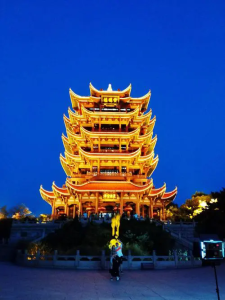Yellow Crane Tower
Introduction to Yellow Crane Tower
Located in Wuchang District, Wuhan City, Hubei Province, the Yellow Crane Tower is a landmark building in Wuhan City. It is located at the top of Snake Mountain and near the Yangtze River. The Yellow Crane Tower was built in the second year of Wu and Huang Wu of The Three Kingdoms (223), and the existing buildings were designed with the “Tongzhi Tower” as the prototype and rebuilt in 1985. The Yellow Crane Tower is famous all over the world because of the poem “Yellow Crane Tower” written by the Tang Dynasty poet Cui Hao. It has the reputation of “the best scenery in the world” since ancient times. Together with Qingchuan Pavilion and Guqin Terrace, it is called “Three major scenic spots in Wuhan”, together with Yueyang Tower in Hunan Province and Tengwang Pavilion in Nanchang, Jiangxi Province, it is called “Three famous buildings in South China”. It is the first of the “Ten scenic spots in Wuhan”, one of the “Four famous buildings in Ancient China”, one of the “Ten famous historical and cultural buildings in China”, and is known as “the first floor of the world”.

Legend
The legend of Yellow Crane Tower is composed of fairy legend, celebrity anecdote and historical story. Its titles include “Zi ‘an Riding the Crane”, “Fei Yi ascending to Heaven”, “Fairy playing flute”, “Orange peel Painting Crane” and so on. The legend of the Yellow Crane Tower began in the Southern and Northern Dynasties. It was first recorded by the scientist Zu Chongzhi in the Southern Dynasties. His strange novel Shu Yi Ji contains the story of Xun 瓌 of Jiangling who met the guest who drove the crane in Huanghu (Crane) Tower. The name of the Yellow Crane Tower mainly has two sayings: “because of the mountain” and “because of the fairy”. Among them, “because of the immortal said” divided into two, one said that there had been a fairy crane through this, so the name; It is said that a Taoist priest once painted a dancing yellow crane on the wall of Xin’s restaurant here, and the business of the shop was very prosperous. Ten years later, the Taoist priest came again and called the yellow crane with the sound of the flute, and flew away by the crane. “Because of the mountain theory” believes that the name of the Yellow Crane Tower is because it is built on the Yellow Hu Mountain.
history
The Yellow Crane Tower was built in the second year of Wu and Huang Wu in The Three Kingdoms Period (223), and legend has it that it was built for military purposes. After the Jin Dynasty destroyed the Eastern Wu Dynasty, the building lost its military value at the same time, with the development of Jiangxia city, gradually evolved into the official and commercial travel “tour must be”, “banquet must be” ornamental building. To the Tang Dynasty, its military nature gradually evolved into a famous scenic spot, literati and writers of all generations to visit this, leaving many popular poems. The Yellow Crane Tower has been destroyed and built repeatedly in history, only in the Ming and Qing dynasties, it was destroyed 7 times, and rebuilt and repaired 10 times. The last “Qing Lou” was built in the seventh year of Tongzhi (1868), destroyed in the tenth year of Guangxu (1884), and was not rebuilt for nearly a hundred years after that. In October 1981, the reconstruction project of the Yellow Crane Tower broke ground and was completed in June 1985.

unit
The main building of the Yellow Crane Tower is a four-sided octagonal body, reinforced concrete frame imitation wood structure, 51.4 meters in height, the bottom side is 30 meters wide, the top side is 18 meters wide, the eaves are five layers, the roof is covered with golden glazed tiles, supported by 72 columns, and the upper floor has 60 warpage angles extending outward. Outside the building, there are cast copper yellow crane shape, like pagoda, archway, porch, pavilion and other buildings around, the whole building is like yellow crane, spreading its wings to fly, hanging four boards under the eaves, hanging calligraphers Shutong title “Yellow crane Tower” three-character gold plaque. The Yellow Crane Tower has five floors on the outside and nine floors inside, which implies the supreme meaning of the ninth Five-Year Plan. The crane wing shape of the eight eaves reflects the unique culture of the Yellow Crane Tower, which perfectly combines the traditional Chinese architectural features with cultural meanings.
Sightseeing spots and road map
Yellow Crane Tower Park in addition to the main building, there are a number of tourist attractions, such as Shengxiang Pagoda, the first floor of the three Chu, the Pavilion overlooking the river, the rainbow Pavilion, the “Yellow crane returns” bronze sculpture, the millennium clock. Sightseeing roadmap Suggestions:
West Entrance – Main building visit – Visit surrounding attractions – Millennium Clock, etc. There are also Tanhualin, Hubu Lane, Liangdao Street, Yangtze River Bridge bridgehead, Red Tower and other scenic spots around the Yellow Crane Tower, according to the time